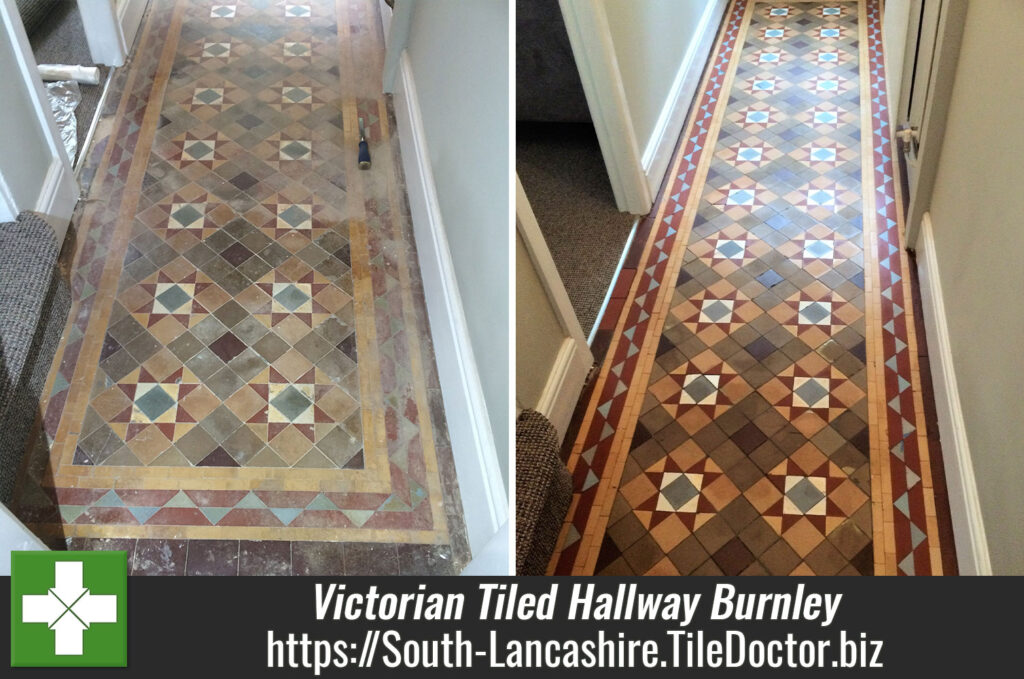Polishing and Sealing a Dull Limestone Tiled Floor in Colne Burnley
Earlier this year I received an enquiry from Colne regarding a Limestone tiled floor that needed attention. The floor had been installed a few years earlier throughout much of the ground floor including the utility, hallway and large kitchen diner. It was last sealed by the installer and since then it had become quite soiled in parts, particularly the heavy traffic areas and grout. The client hoped for a lighter finish, with a light sheen/semi honed finish to the stone and cleaner grout.

The protective sealer had clearly worn down and was now letting dirt into the pores of the stone making it difficult to clean effectively. After surveying the floors, I recommended burnishing the Limestone with a set of diamond pads and then re-sealing the stone with a suitable modern sealer that would give the finish they were looking for. Happy with my quote we set a date to start the work.
 |
 |
Cleaning and Polishing a Limestone Tiled Floor in Colne
Diamond burnishing pads are the best tool for renovating honed stone floors like Limestone and after setting up the equipment work started with the application of a coarse 400-grit pad.

The pad is fitted to a weighted buffing machine and applied to the floor at low speed with water to lubricate the process. This coarse pad strips off old sealers and cleans the stone and is run over each tile three times, once done the resultant soiling is rinsed off with water and extracted with a wet vacuum.
The burnishing process was then continued with finer 800 and 1500-grit pads which slowly restore a honed finish to the stone. After each pad is run over the floor the dirty water was extracted using the wet vacuum as before.
The next step was to scrub the grout joints using a medium dilution of Tile Doctor Pro-Clean. The solution is left to soak into the grout for ten minutes before being scrubbed in by hand with a stiff brush. Once done the now dirty solution was rinsed off with more water and extracted using the very useful wet vacuum.
The floor was then reviewed and any issues spot cleaned using a repeat of the various processes. Part of this work included hand finishing the edges and corners using a set of small hand burnishing blocks of different grits.
A lot of water was used during the cleaning process and the floor needs to be dry before applying the sealer. So once all the work was done the floor was dried as much as possible with the wet vacuum and then left to dry out for 24 hours.
Sealing a Polished Limestone Tiled Floor in Colne
On my return I set about polishing the Limestone using the last pad in the burnishing pad set which is an extra fine 3000-grit. This last pad is applied to the floor dry with only a little water sprayed onto the stone as you progress. It adds a lovely deep shine to the Limestone and leaves the floor dry and ready to be sealed.
To finish Tile Doctor Ultra-Seal was then applied to the Limestone, this is an impregnating sealer that provides a natural look finish. It works by soaking into the stone occupying the pores and thereby preventing dirt from becoming ingrained there, this ensures dirt remains on the surface where it can be easily cleaned away.
 |
 |
The floor looked much cleaner and lighter once done and my client was very happy with the result and left the following comment on our review page:
 |
 |
For aftercare I recommended using Tile Doctor Stone Soap for polished stone floors like this, it is a gentle effective cleaner that’s ideal for cleaning sealed floors and helps to maintain the patina.

Professional Restoration of a Limestone Tiled Ground Floor in South Lancashire
Polishing and Sealing a Dull Limestone Tiled Floor in Colne Burnley Read More »




